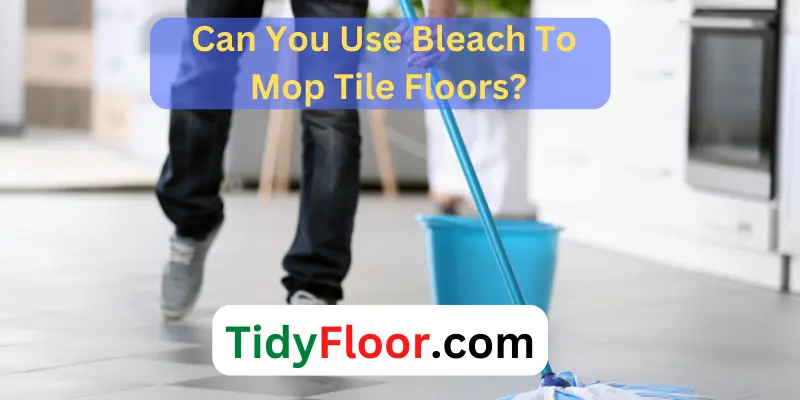Your tile floors get a lot of foot traffic. Unfortunately, it brings a mixture of different types of bacteria and germs. These germs often cause allergies and other breathing issues. So, you’re seeking an explanation for the question, “Can you use bleach to mop tile floors?”
In a word, it is better to use bleach when mopping the tile floors. Since the tile floor is not a perforated surface, using bleach is the best option to sweep without hesitation. This is an economical and effective disinfectant for tile floors. Bleach is known as an anti-allergic ingredient.
The whole process of how to use bleach on a tile floor is summarized below. Keep reading to learn all about bleach activity during tile floor mopping. Moreover, you will know the advantages and disadvantages of using bleach on tile floors.
6 Steps To Mop Tile Floors With Bleach: 6 Simple Steps
There is no doubt that bleach is an excellent cleaner and disinfectant. But you need to know the exact process of using it. The steps for using bleach during tile floor mopping are described below.
Step-1: Needed Materials
The tile floor needs to be maintained regularly to keep it germ-free. Bleach is very effective in disinfecting. The following materials and tools are required to keep the tile floor clean and germ-free.
- Protective gloves,
- Broom or vacuum,
- Scrub brush or sponge,
- Plastic bucket,
- Measuring cup,
- Clean water,
- Bleach (Clorox®).
Step-2: Improve Ventilation
You should check your ventilation system before cleaning the tile floor of an enclosed space. Open every window in the room. If there is no window in the room, you can use the fan. This will improve the air circulation in the environment. Since water is used with bleach during cleaning, air circulation is essential.
Step-3: Sweep Up To Remove Loose Dirt And Dust
Clean excess loose dust before applying a bleach solution to the tile floor. This will make it easier to apply the bleach solution to the floor. As a result, they will be visible if there is solid dirt. You can use an ordinary broom or vacuum to clean up loose dust. If possible, you can move the furniture off the floor.
Step-4: Mix Bleach And Water Together
Wear protective gloves before mixing bleach and water. Also, wear clothes that do not cause bleaching problems. Then take a clean plastic bucket. Pour 1 gallon of clear and cold water into the plastic bucket. Then add 1/3 cup of bleach (Clorox®).
If hard stains appear on a specific area of your tile floor, it is not possible to clean it with an ordinary solution. Then make a powerful cleaning solution by adding 1 part bleach to 2 parts water.
Step-5: Scrub The Floor With A Sponge Or Mop
You should apply the solution (1 gallon of water + 1/3 cup bleach) thoroughly all over your tile floor. It should take about 6 minutes to clean the tile floor thoroughly. Then scrub well with a scrub brush or sponge.
You can also apply the powerful cleaning solution (1-part bleach + 2-parts water) to solid dirt. After waiting for 10–12 minutes, scrape off the solid dirt. Remember, it is better not to apply this powerful cleaning solution to the entire tile floor.
Step-6: Rinse Thoroughly With Clear Water And Wait To Air Dry
Finally, rinse the tile floor thoroughly with clear water. Also, wash the necessary tools (bucket, scrub brush, sponge) with clean water. Wait until the tile floor is arid. It is not safe to walk on a tile floor until it has completely dried.
Benefits Of Using Bleach To Mop Tile Floors
Bleach is very popular for floor cleaning as it is readily available. There are some advantages to using bleach on the tile floor during mopping. Here are the benefits of using bleach in mopping.
- Antimicrobial Capacity
Bleach contains a compound called sodium hypochlorite, which has antimicrobial power. Several research institutes have found evidence of the resistance of sodium-hypochlorite against biofilm. So you can say that it is very effective against germs. A few drops of bleach are enough to thoroughly clean and disinfect your tile floor.
- Eliminates Allergens
Mild humidity promotes the growth of different species of fungi. The spores of these fungi cause allergic symptoms. This can cause sneezing, runny nose, cough, itching, shortness of breath, etc.
Bleach prevents the growth of these fungi on your tile floor. Bleach during tile floor mopping keeps your floor germ free and provides a healthy environment.
- Increases The Brightness Of The Tile Floor
The tile floor is gray due to various fungi. Also, the brightness of the tiles decreases due to dust and germs. If you use bleach during mopping, the color of your tiles will be naturally rich. You apply a solution of 1/3 cup bleach with 1 gallon of water to your tile floor.
- The Price Is Affordable
Bleach is cheaper than any other disinfectant. For this reason, the University of Florida considers this bleach solution to be the most common and inexpensive disinfectant. The average price of 1 gallon of bleach is $3 to $4.
Contradictory to this, other cleaning agents cost more than $10 per gallon. Besides, you don’t have to spend a lot of money because you don’t need much bleach solution during mopping.
Disadvantages Of Using Bleach To Mop Tile Floors
There are advantages to using bleach on the tile floor and some disadvantages. If not used properly, bleach can cause many problems. However, note the following drawbacks:
- Can Be Dangerous
Keep bleach away from any acidic or alkaline solutions. Mixtures of bleach and other chemicals can be dangerous. Water is neutral, so there is no complication in mixing water. The national poison data system of the U.S. cities blames bleach as a frequent cause of poisoning in their reports.
- Irritation Of The Skin
Bleach can irritate your skin. Bleach can also cause itching and inflammation of the skin. When using bleach in mopping, it is essential to ensure that bleach does not touch the body. Wear gloves and clothing when using bleach to protect against skin irritation.
Related Question About Using Bleach On The Tile Floor:
Is Bleach Safe To Use On Hardwood Floors?
Generally speaking, you should not use bleach on hardwood floors. The wood’s cellulose, lignin, and hemicelluloses react with the bleach. This can damage your hardwood floor. However, a polyurethane finish is often used on hardwood floors.
You can use bleach if this polyurethane finish exists on the hardwood floors. You can experiment with small covered areas to see how bleach reacts to your hardwood floor. If the polyurethane finish is worn out, there is no need to use bleach.
Do You Need To Rinse Floor After Mopping With Bleach?
This is a crucial step. After using bleach, you should wash the floor properly. If you don’t rinse the floor after mopping with bleach, its toxic fumes will be mixed into the air. There is a possibility of various diseases, including shortness of breath.
Furthermore, if the remaining bleach is not washed off, it may accumulate down the edges of the tile. This will ruin your tile floor over time. So it is essential to wash the floor thoroughly after mopping with bleach.
Will Bleach Hurt Ceramic Tile?
Bleach is very reactive, which can destroy the coating of any tile. Ceramic tile has a bright layer. Therefore, mopping ceramic tiles with bleach can be harmful. The luminous coating of ceramic tile can lose its luster. The use of bleach can cause your ceramic tile to fade.
So, you will never see that bright glow again. Ceramic tile does not accumulate solid dirt. Therefore, use a soft cleaner to clean ceramic tile. Mild dish soap with warm water is suitable for ceramic tile.
Is Mopping Tile Floors With Bleach Safe?
Using bleach on the tile floor during mopping is a great idea. Feel free to use bleach when mopping your tile floor. It is safe to use. The tile floor is not perforated, and its surface is sealed. So it is safe to use bleach on the tile floor during mopping.
Bleach is used on tile floors as a reliable disinfectant. It kills germs and bacteria on the tile floor. This will keep you safe from all allergies. However, bleach is unsafe for any perforated surface.
What Happens When You Mop With Bleach?
The use of bleach when mopping your tile floor is an effective way to sanitize it. Bleach makes the floor healthier by destroying any harmful germs and bacteria that are present on it. The cost of bleach is less than any commercial cleaning solution, but you get the same results.
Using bleach during floor mopping will not cause any softening, mold, or spores. This is good news for those who have allergies. Also, bleach is great for any non-porous floor and grout. To keep your tile floor clean and free of bacteria, mop it weekly with a bleach solution.
Final Verdict:
You will no longer be worried about the use of bleach for I’m confident you’ll now use bleach on your tile floor to feel comfortable. However, be aware of the risks before using bleach.
Wear hand gloves before using bleach, and make sure that bleach doesn’t get in your eyes. When using bleach on the tile floor, ensure that no children or pets are around.


